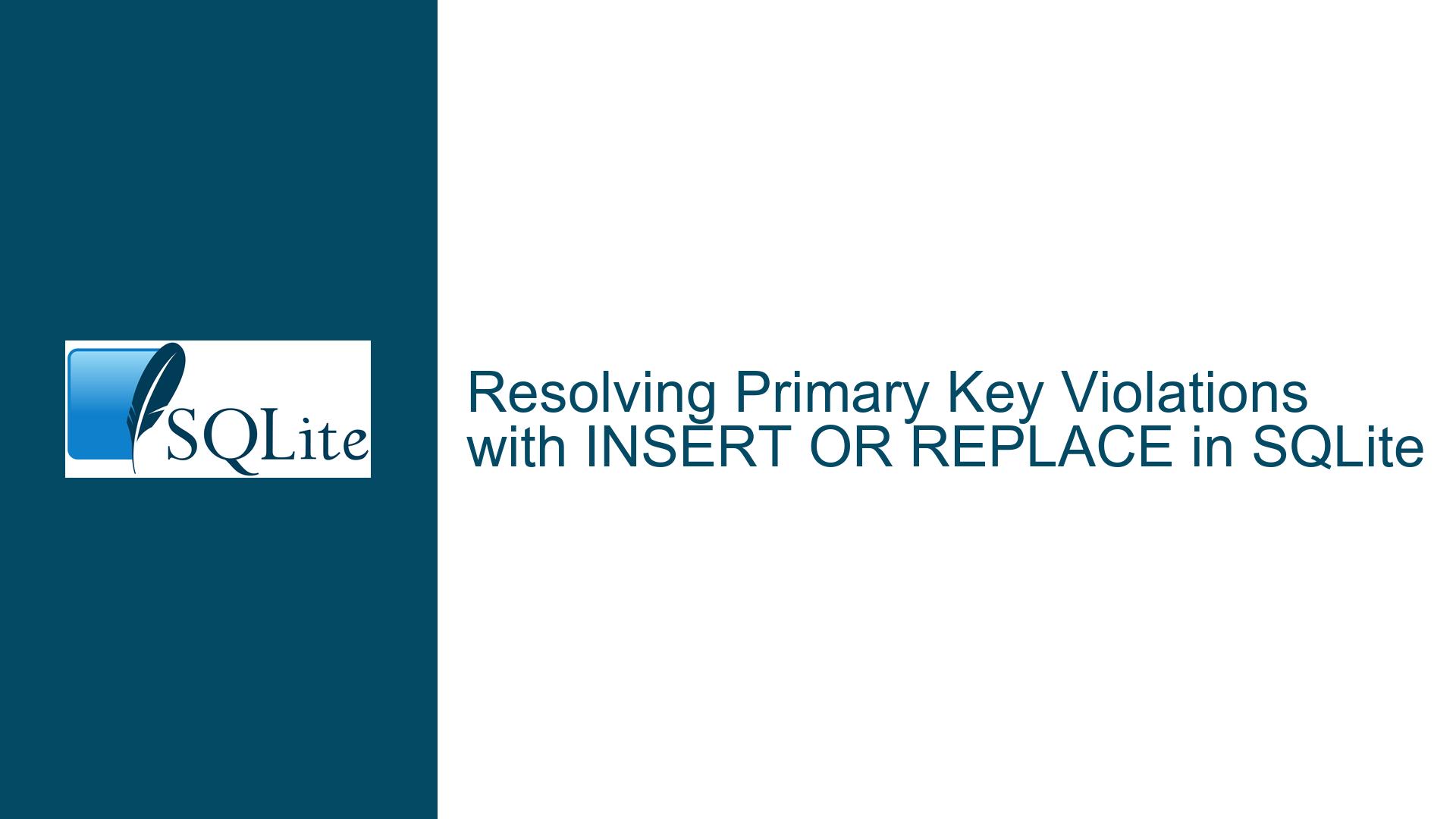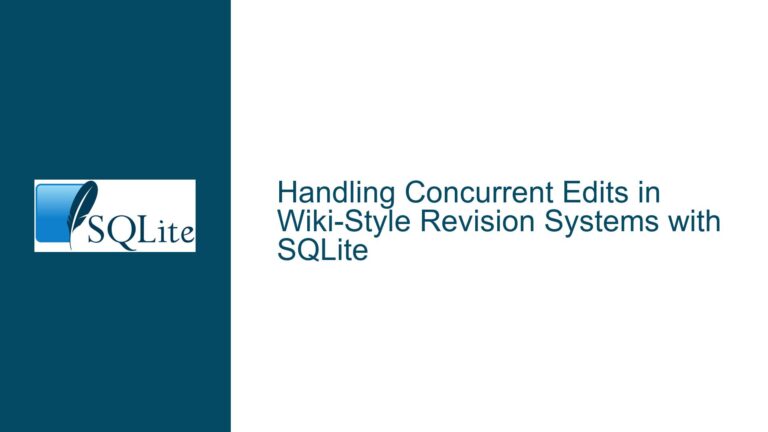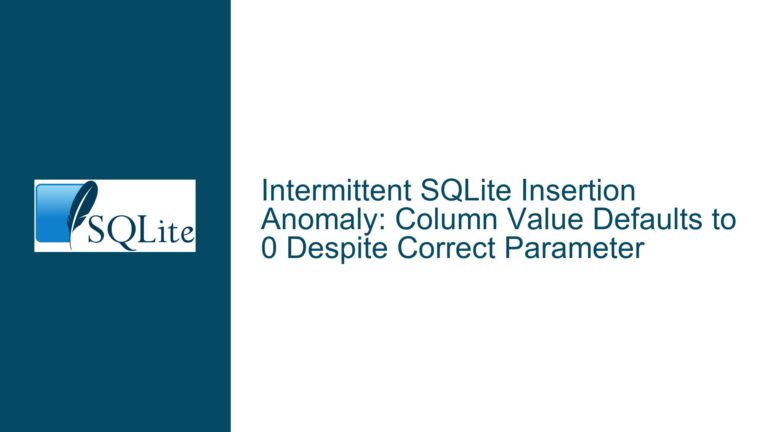Resolving Primary Key Violations with INSERT OR REPLACE in SQLite
Unexpected Primary Key Violation During INSERT OR REPLACE Operations
The INSERT OR REPLACE clause in SQLite is designed to handle constraint violations by replacing existing rows that conflict with the new data. However, users may encounter unexpected primary key violations when executing such statements, even when the conflict resolution clause (OR REPLACE) is explicitly declared. This issue arises when the database engine fails to execute the replacement logic as intended, leading to errors such as UNIQUE constraint failed or PRIMARY KEY must be unique.
Core Mechanism of INSERT OR REPLACE
SQLite’s INSERT OR REPLACE operates under a specific algorithm:
- Conflict Detection: The engine attempts to insert the new row.
- Constraint Check: If a uniqueness violation (e.g., primary key or unique index conflict) occurs, the engine identifies the conflicting row.
- Row Replacement: The conflicting row is deleted, and the new row is inserted in its place.
This process should prevent primary key violations under normal operation. However, the error persists in certain scenarios due to misconfigurations, environmental factors, or hidden dependencies.
Key Symptoms
- The
INSERT OR REPLACEstatement throws aSQLITE_CONSTRAINT_PRIMARYKEYerror. - The error occurs intermittently or consistently, depending on data patterns.
- The behavior is reproducible only in specific environments (e.g., a C/C++ application) but not in the SQLite CLI.
Potential Causes of Primary Key Conflicts Despite OR REPLACE Clause
1. Programming Environment-Specific Behavior
SQLite’s behavior can vary across programming languages or database drivers due to:
- Version Mismatches: The application might use an older SQLite version lacking optimizations or bug fixes related to conflict resolution.
- Driver Configuration: Database drivers (e.g.,
sqlite3in Python,System.Data.SQLitein C#) may override default conflict resolution logic or mishandle prepared statements. - Transaction Isolation: Concurrent transactions or improper isolation levels might lock rows, preventing the
DELETEphase ofOR REPLACEfrom completing.
2. Trigger Interference
Triggers defined on the target table can disrupt the conflict resolution process:
- BEFORE INSERT Triggers: A trigger might modify column values before insertion, inadvertently creating a new conflict not accounted for by the original
OR REPLACElogic. - AFTER DELETE Triggers: If the replacement process deletes a row, triggers might perform additional operations that reintroduce conflicts (e.g., cascading updates to related tables).
3. Schema Design Limitations
- Composite Primary Keys: When the primary key spans multiple columns, the conflict resolution logic might not correctly identify the overlapping rows.
- Implicit Indexes: SQLite automatically creates indexes for primary keys. Corruption or improper configuration of these indexes can lead to false conflict detection.
Diagnosing and Resolving OR REPLACE Conflict Resolution Failures
Step 1: Isolate the Environment
Verify SQLite Version
ExecuteSELECT sqlite_version();in the application to confirm the linked SQLite library version. Versions prior to 3.24.0 (2018-06-04) lack optimizations for complex conflict resolution scenarios.
Example in C:sqlite3_exec(db, "SELECT sqlite_version();", print_version_callback, NULL, NULL);Reproduce in SQLite CLI
Run the exactINSERT OR REPLACEstatement in the standalone SQLite command-line interface (CLI). Success here indicates an environment-specific issue.
Example:INSERT OR REPLACE INTO tblname VALUES ('test', 1), ('test', 2);
Step 2: Audit Triggers and Schema
List Active Triggers
Querysqlite_masterto identify triggers associated with the table:SELECT name, sql FROM sqlite_master WHERE type = 'trigger' AND tbl_name = 'tblname';Temporarily disable triggers to test if they cause conflicts:
DROP TRIGGER trigger_name; -- Re-test INSERT OR REPLACEAnalyze Schema Constraints
Ensure no hidden unique indexes or constraints exist:PRAGMA index_list(tblname); PRAGMA foreign_key_list(tblname);
Step 3: Debug the Application Code
Parameter Binding Verification
In C/C++, incorrect parameter binding can cause duplicate keys. Validate that bound values (e.g.,sqlite3_bind_text) match the expected primary key.
Example:sqlite3_stmt *stmt; sqlite3_prepare_v2(db, "INSERT OR REPLACE INTO tblname VALUES (?, ?)", -1, &stmt, NULL); sqlite3_bind_text(stmt, 1, str_value, -1, SQLITE_STATIC); // Ensure str_value is unique sqlite3_bind_int(stmt, 2, len_value);Concurrency Controls
Use explicit transactions to isolate theINSERT OR REPLACEoperation:sqlite3_exec(db, "BEGIN;", NULL, NULL, NULL); // Execute INSERT OR REPLACE sqlite3_exec(db, "COMMIT;", NULL, NULL, NULL);
Step 4: Advanced Diagnostics
SQLite Trace and Profile Hooks
Enable logging to capture the exact sequence of operations:sqlite3_trace_v2(db, SQLITE_TRACE_STMT, (int (*)(unsigned, void*, void*, void*))trace_callback, NULL);Corruption Checks
Run integrity checks to rule out database corruption:PRAGMA quick_check;
Final Fixes
- Upgrade SQLite: Ensure the application uses SQLite 3.24.0 or newer.
- Simplify Triggers: Refactor triggers to avoid side effects during replacement.
- Explicit Index Management: Recreate the primary key index if corruption is suspected:
REINDEX tblname;
By systematically addressing environmental factors, triggers, and schema design, developers can resolve primary key violations and restore the intended behavior of INSERT OR REPLACE.






